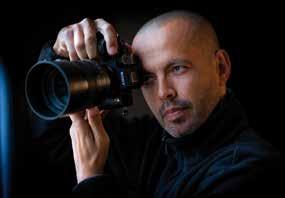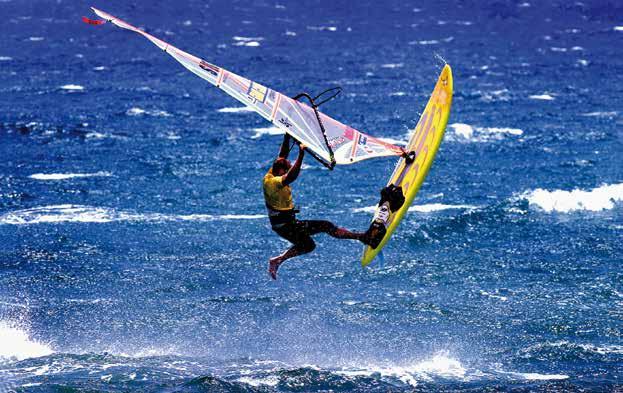
8 minute read
The magic of imagery
La magica arte dell’immagine
Nella sua carriera di fotografo professionista, wAngelo Trani ha ritratto numerosi vip del mondo dello spettacolo. Ma tutto è iniziato con la passione per l’automobilismo e con uno stratagemma per entrare alle corse… The Magic Art of Imagery In his career as a professional photographer, Angelo Trani has taken pictures of a slew of celebrities from the world of entertainment. But it all started with a passion for cars and a ploy to get into a race for free…
Advertisement

Natale a casa Del Santo
Il backstage del servizio fotografico dedicato alla showgirl Lory Del Santo
Christmas chez Del Santo
The backstage of the shoot dedicated to showgirl Lory Del Santo
Ottantamila chilometri
all’anno per raggiungere le location dove scatterà i suoi prossimi servizi, e pensare che tutto è nato per poter scroccare l’ingresso a una corsa automobilistica. Neanche Angelo Trani, 46 anni, avrebbe immaginato 25 anni fa di potere realmente diventare un fotografo professionista. Dalla provincia di Siena, dove ha il suo quartier generale, a Los Angeles, New York, sono molte le mete da raggiungere per ritrarre i suoi protagonisti, soprattutto personaggi famosi. In carriera ha ritratto da Bruce Springsteen a Ligabue, da Joe Bastianich al premio Oscar Gabriele Salvatores. Cominciamo però dall’inizio: ancora ragazzino Trani si appassiona alla macchina fotografica: “Iniziai a usare la reflex di mio padre dopo un breve corso, frequentavo le scuole medie – racconta il fotoreporter a Spazio Italia – la fotografia è diventata subito una passione. Poi un corso professionale a Firenze, a quel tempo dove vivevo non c’era nulla, solo gruppi di appassionati. Arrivò subito dopo il primo lavoro, in un’agenzia. Il lavoro di fotografo era però più una scusa per entrare a vedere corse automobilistiche, la mia grande fissa del tempo. Ho anche disputato gare amatoriali di Go Kart. Per un po’ lavorai per quest’agenzia bolognese, era fra le più importanti ma pagavano poco. In più dovevi avere attrezzatura tua. I miei però mi supportavano”. Prima cosa quindi: procurarsi l’attrezzatura. “Ricordo una spedizione mitica – continua – con mio padre, a Livigno. Lì si comprava bene, nella zona extra dogana. Ci mettemmo in contatto con i venditori e tornammo con 10 milioni di lire di attrezzatura”. Foto sportive per l’inizio, ma ben presto l’intuito lo condusse su strade più redditizie, sempre in nome dell’arte dello scrocco: “Adoravo i concerti e fare belle foto poteva risolvere il problema dell’ingresso. Iniziai a chiedere accrediti in cambio di foto, ma scattare lì era una sfida ardua. Oggi, con il digitale, possiamo controllare immediatamente il risultato,
Globetrotter
Angelo Trani è molto apprezzato come ritrattista, ma ultimamente viaggia molto anche per fotografare location particolari Angelo Trani is a successful portrait photographer, but lately he’s also been travelling widely to shoot special locations
Angelo Trani is now 46 and clocks up a cool eighty thousand
kilometres a year as he hops from location to location for his photo shoots, yet it all started when he wanted to scrounge free entrance to car races. 25 years ago, Trani never even imagined that he would really become a professional photographer. Yet here he is, constantly setting out from his headquarters in the province of Siena to Los Angeles, New York and a host of other destinations to portray his various subjects, many of them famous. In the course of his long career he has photographed everyone, from Bruce Springsteen to Ligabue, Joe Bastianich and Oscar winner Gabriele Salvatores.

But let’s start from the beginning, right from boyhood Trani was passionate about photography. “I started using my father’s SLR after a short course at middle school” he explained to Spazio Italia, “and photography immediately became a passion. Later I attended a professional level course in Florence, back in the day there was absolutely nothing where I lived, just amateur hobby groups. I started working for an agency more or less immediately, my first job. But it was actually just an excuse to get into car races, which I had always been obsessed by. In fact, I used to race in amateur Go Kart events. So I worked for this agency in Bologna for a while, it was one of the leading agencies, but the pay was terrible. And you had to provide all your own equipment, but luckily the bank of mum and dad helped out.” The first thing then was to get kitted up. Trani continues “I remember what was to prove a legendary expedition with my father to Livigno on the Swiss border, where there was a duty-free area with some great savings to be had. We got in touch with the vendors and came back home with 10 million lire (5000 euros) worth of equipment.” He started off concentrating on sporting events, but soon realised where the pickings were richer and where he could swing more freebies for another of his passions. “I adored going to concerts and taking pictures was one way of taking care of the cost of the tickets. So I started to ask around for free press passes in exchange for photos, but it was a huge challenge. Nowadays with digital photography you can check your results in real time and touch things up afterwards, so we can take as many shots as we want. Back then it was all on film and developing was
possiamo intervenire dopo, possiamo scattare tantissimo. Al tempo c’era la pellicola, sviluppare era molto costoso, così mi limitavo a tre rullini”. Tutt’oggi Trani continua a seguire le tournée di grandi artisti, è il fotografo ufficiale per i live, ad esempio di Claudio Baglioni. “La vera intuizione fu quando decisi di diventare ritrattista. Era stimolante, potevi incontrare e conoscere i personaggi. Il primo servizio commissionato fu in casa di Lory Del Santo. Quel Natale la showgirl volle festeggiarlo con un servizio. Andò bene, diventò la copertina di Novella 2000”. La Del Santo prima e poi Salvatores, nel deserto californiano del Joshua Tree: “Quello è uno dei servizi che mi ha dato più soddisfazione. Lavoravo a Los Angeles. Riuscimmo a combinare un appuntamento con il regista. Lui era con Fabio De Luigi e decisero di dirigersi verso il deserto. Si creò veramente una bella atmosfera. Non è sempre così quando fotografi i personaggi. Capita che siano nervosi e diventino aggressivi. Ogni volta la vivo come un incontro di boxe”. La vera svolta però arriva incontrando Gianni Morandi: “Lo avevo fotografato in passato – racconta – ed eravamo in amicizia così quando ci fu il tour ‘Capitani coraggiosi’ con Baglioni, lo chiamai per chiedere di seguire le prove. Ne venne fuori un contratto come fotografo ufficiale del tour. È meraviglioso quando hai accesso a tutte le aree di un concerto. Morandi è veramente inarrestabile, può cantare sul palco e dare insieme indicazioni per posizionarmi meglio”. Trani ormai è principalmente un ritrattista, ma ha puntato anche su un altro settore: “Ultimamente viaggio molto anche per fotografare location particolari”. Un’esperienza più che ventennale, ma è difficile anche per lui, oggi che tutti scattano foto, definire una foto riuscita: “Io sono ipercritico, per me è riuscita quando mi piace e quando sento che qualcuno l’apprezza. Per quanto riguarda i ritratti: devi cogliere aspetti nascosti di una persona”.

an expensive business, so I used to limit myself to shooting three rolls of film.” Trani still goes on tour with well-known artists; he’s the official live photographer of the famous Italian singer-songwriter Claudio Baglioni, for example. “But the real game-changer was when I decided to focus on portraits. It was exciting to meet and get to know all those A-listers. My first job was for actress and showgirl Lory Del Santo. It was Christmas, and she wanted to celebrate with a photo shoot. Everything worked out and one of my pictures made the cover of the very popular gossip magazine Novella 2000”. After Ms Del Santo came Salvatores, in the Californian desert of the Joshua Tree National Park. “I really enjoyed doing that gig. I was working in Los Angeles. We managed to nab a date with Salvatores. He was with Fabio De Luigi and they decided to head out into the desert. The atmosphere was really great, which isn’t always the way things go when you’re taking pictures of famous people. Sometimes they’re uptight and become aggressive. Sometimes it can be like psyching yourself up for a boxing match.” His meeting with überfamous Italian singer Gianni Morandi proved decisive. “I’d taken pictures of him in the past,” Trani tells us “and we’d got on well together, so when he decided to tour with Baglioni in ‘Capitani Coraggiosi’ I called him to ask if I could sit in on the rehearsals. I subsequently came away with a contract as the tour’s official photographer. Having privileged access to each and every nook and cranny of a concert is a unique experience. Morandi is an absolute volcano, he can be signing live on stage and still be signalling to me to get the best angle.” Nowadays Trani focuses mainly on portraits, but he is also keen on another sector. “Lately I’ve been travelling widely to photograph special locations”. Despite his twenty years of professional experience even Angelo finds it difficult, in today’s world where everyone takes photos, to define what makes a great shot. “I’m very critical, it’s a good shot when I like it and when I feel that someone else will like it too. As far as portraits go, it’s a question of finding the subject’s hidden depths.”



Cinema italiano
Angelo Trani con Claudia Pandolfi, Leonardo Pieraccioni e Gabriele Salvatores
Italian cinema
Angelo Trani with Claudia Pandolfi, Leonardo Pieraccioni and Gabriele Salvatores






